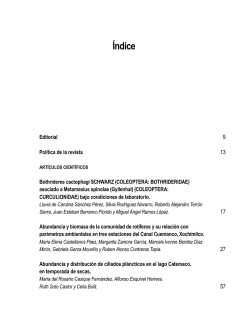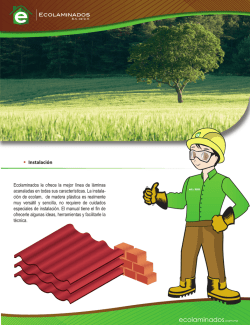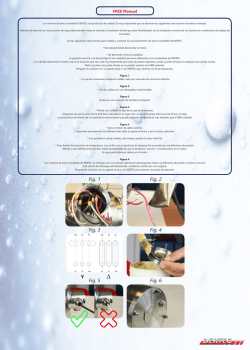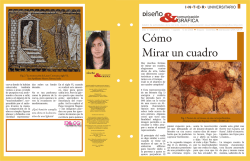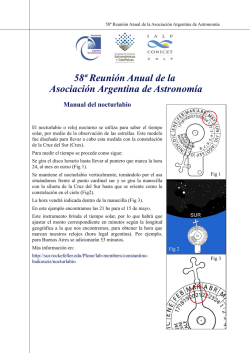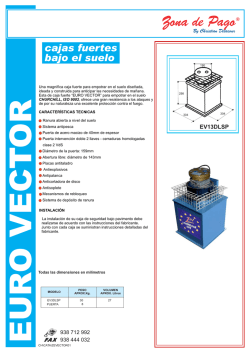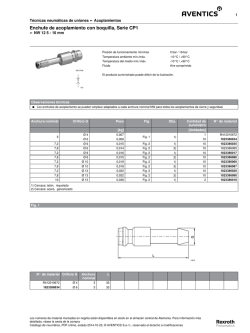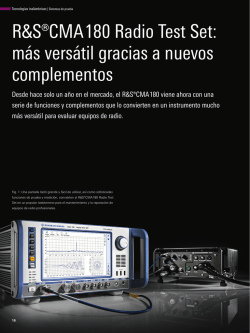
Dugesiana, Año 22, No. 1, Enero-Junio 2015, es una publicación
Dugesiana, Año 22, No. 1, Enero-Junio 2015, es una publicación Semestral, editada por la Universidad de Guadalajara, a través del Centro de Estudios en Zoología, por el Centro Universitario de Ciencias Biológicas y Agropecuarias. Camino Ramón Padilla Sánchez # 2100, Nextipac, Zapopan, Jalisco, Tel. 37771150 ext. 33218, http://dugesiana.cucba.udg.mx, [email protected]. Editor responsable: José Luis Navarrete Heredia. Reserva de Derechos al Uso Exclusivo 04-2009-062310115100-203, ISSN: 2007-9133, otorgados por el Instituto Nacional del Derecho de Autor. Responsable de la última actualización de este número: Coordinación de Tecnologías para el Aprendizaje, Unidad Multimedia Instruccional, M.B.A. Oscar Carbajal Mariscal. Fecha de la última modificación 30 de Junio 2015, con un tiraje de un ejemplar. Las opiniones expresadas por los autores no necesariamente reflejan la postura del editor de la publicación. Queda estrictamente prohibida la reproducción total o parcial de los contenidos e imágenes de la publicación sin previa autorización de la Universidad de Guadalajara. Dugesiana 22(1): 5-7 Fecha de publicación: 30 de junio de 2015 ©Universidad de Guadalajara ISSN 1405-4094 (edición impresa) ISSN 2007-9133 (edición online) Two new Staphylinid Species from Mexico (Coleoptera, Staphylinidae)1 Dos especies nuevas de estafilínidos de México (Coleoptera, Staphylinidae)1 Volker Puthz Burgmuseum Schlitz, Vorderburg 1, D-36110 Schlitz, Germany ABSTRACT Two new Staphylinid species are described from Mexico, Veracruz: Stenus baumanni sp. nov. and Megalopinus baumanni sp. nov., Stenus tricornis nom. nov. = Stenus tricuspis Puthz, 2014 nec Puthz 1984. Key words: Coleoptera, Staphylinidae, Steninae, Megalopsidiinae, Mexico. RESUMEN Se desciben dos especies de Staphylinidae de Mexico, Veracruz: Stenus baumanni sp. nov. et Megalopinus baumanni sp. nov., Stenus tricornis nom. nov. = Stenus tricuspis Puthz, 2014 nec Puthz 1984. Palabras clave: Coleoptera, Staphylinidae, Steninae, Megalopsidiinae, Mexico. Amongst a large collection of Steninae from the Arthropod Collection of the Monte L. Bean Life Science Museum, Brigham Young University, Provo, U.S.A. there were found two new species from Mexico which are described here. Abbreviations: DE= average distance between eyes; EL= greatest length of elytra; EW= greatest width of elytra; HT= holotype; HW= head width; PL= pronotal length; PM = proportional measurements (1 unit = 0,025 mm); PT/T: paratype/s; PW= pronotal width; SL= sutural length of elytra. TAXONOMIC PART Stenus baumanni sp. nov. Description: Macropterous, black with a slight plumbeous hue, shiny, forebody coarsely and densely punctate, abdomen with moderately coarse, dense punctation anteriorly, moderately finely and moderately sparsely punctate posteriorly; pubescence indistinct. Antennal base yellow, club yelllowish-red. Maxillari palpi yellow. Legs yellow, apical portions of femora slightly infuscate as are apices of tarsal segments. Clypeus dark brown, densely pubescent on either side of the middle line, labrum light brown anteriorly, brown posteriorly. Abdomen ummargined, tarsi bilobed. Length: 4.2-4.8 mm (forebody 2.0-2.2mm). PM of HT: HW: 32; DE: 18; PW: 23,5; PL: 31; EW: 35; EL: 40; SL: 34. Head narower than elytra, frons broad, shallowly concave, longitudinal furrows very shallow, median portion indistinctly separate from lateral portions, slightly elevated, not extending to the level of medial eye margins; punctation moderately coarse and dense, diameter of punctures about equal to medial cross section of antennal segment 3, interstices mostly smaller than punctures, as large as in places near medial eye margins posteriorly and along actual middle (but this has no distinct separate shining area). Antennae very long, when reflexed the last two segments extending beyond the posterior margin of the pronotum, penultimate 1 segments twice as long s broad. Pronotum much longer than broad, broadest slightly behind middle, sides from there first convergent in straight lines anteriad, more strongly constricted near anterior margin, sides posteriorly slightly concave; no impressions; punctuation coarse and dense, diameter of punctures about as large as apical cross section of antennal segment 2, interstices mostly smaller than half diameter of punctures, may be larger along posterior middle. Elytra subquadrate, longer than broad, shoulders rectangular, sides nearly straight, distinctly constricted in posterior fourth; sutural and humeral impressions indistinct; punctuation about as coarse as on pronotum, slightly less dense in sutural third. Abdomen cylindrical, basal constrictions of anterior segments deep, tergite 7 with a distinct membranous fringe posteriorly; punctuation of anterior tergites about as coarse as on frons, dense, posteriorly slightly less dense, punctuation of tergite 7 distinctly finer, punctures about as large as eye facets at medial eye margins, interstices nearly twice as large as punctures. Legs very slender, metatarsi nearly three fifths as long as metatibiae, segment 1 nearly as long as segments 2-4 combined, much longer than the last segment; segments 3 and 4 broadly bilobed. Forebody without microsculpture, abdominal tergites 7-10 distinctly reticulated. Male: Legs simple. Sternite 7 with a broad and shallow apical emargination. Sternite 8 (Fig. 1), sternite 9 (Fig. 8), tergite 10 (Fig. 5). Aedeagus (Fig. 7, apical portion of median lobe narrowly acutely pointed with few apical setae; a strong and very long tube projecting from the basal portion of the median lobe; parameres very long, much entending beyond the apex of the median lobe, with about 16-18 setae in apical third. Female: Sternite 8 (Fig. 3), posterior margin with a slight median projection. Valvifer with a short and distinct tooth apicolaterally. Tergite 10 (Fig. 2). Type material: Holotype (♂) and 1♂, 3♀♀-paratypes: MEXICO: Veracruz: Rio Laguna Escondida, Los Tuxlas Biological Station, 17.XI.1993, R. W. Baumann (together with Stenus albipes Sharp and S. cylindricus Sharp).- HT and PTT in the Monte L. 340th contribution to the knowledge of Steninae and 29th contribution to the knowledge of Megalopsidiinae. Dugesiana Bean Life Science Museum, Provo, U.S.A., 2 PTT in the author’s collection. Discussion: This new species belongs to the ariolus-group (Puthz, 2007) and closely resembles S. macehualli Puthz from San Luis Potosi (Puthz, 2014). In this species the base of elytra is not distinctly pubescent (as is often the case in the ariolus-group). It may be distinguished from it by the less broad head, the reticulate tergite 7 and the shorter apicolateral teeth of sternum 9 (the male of S. macehualli is unknown). Since the new species differs from many of its group relatives by the lack of conspicuous pubescence it may be easily misidentified as a member of the cupreus-group (Puthz, 1984), particularly with the common and widely distributed S. albipes Sharp. From this species and from S. cylindricus Sharp it may be distinguished by the nearly smooth posterior margin of tergite 10 (compare Fig. 4), the different posterior shape of sternum 9 (Fig. 6) and by the morphology of aedeagus. Etymology: This new species is named in honour of the collector, Richard W. Baumann (Provo). Stenus tricornis nom. nov. Stenus tricornis new name for Stenus tricuspis Puthz, 2014: 1698 (junior homonym) nec Puthz, 1984: 77 (senior homonym). By mistake the specific epithet tricuspis has been published twice. This is corrected here. Megalopinus baumanni sp. nov. Description: Black, shiny, elytra with an indistinctly limited reddish yellow pattern (Fig. 10) and two short rows of punctures. Antennal base yellowish, club slightly darker. Maxillary palpi yellowish-brown. Legs completely yellowish brown. Length: 2.8-3.4mm (forebody 1.7mm). PM of HT: HW: 32; DE: 19; PW: 25; PL: 24,5; EW: 38; EL: 37; SL: 30. Head distinctly narrower than elytra, punctuation of frons moderately coarse, sparse, 17 punctures on actual middle. Pronotum about as long as broad, without lateral teeth, sides convex in anterior half, concave posteriorly; punctuation coarse, moderately sparse, transverse impressions moderately deep. Elytra about as long as broad, punctuation as in Fig. 10. Lateral stria of tergite 5 not extending to the middle of the tergite, paratergites smooth. Male: Antennal segment 11 nearly three fifths ad broad as long (17: 22). Posterior margin of sternite 8 concave on each side, slightly projecting in the middle. Tergite 10 impunctate. Aedoeagus (Fig. 9), median lobe with 4 strong spines, parameres without apical setae. Female: Unknown. Type material: Holotype (♂): MEXICO: Veracruz: Ria Laguna Escondida, Los Tuxtlas Biological Station, 17.XI.1993, R. W. Baumann: In the Monte L. Bean Life Science Museum, Provo, U.S.A.. Discussion: This new species belongs to the mixed group 4 of the punctatus-group (definition see Puthz, 2012: 618), its elytral pattern closely resembles that of M. cruciger (Sharp), from which it may be distinguished by the longer elytra, narrower head, minor length and the morphology of aedeagus (compare Fig. 1, Puthz, 1976). In my key to the neotropic Megalopinus it should be inserted at column 78 Etymology: This new species is named in honour of the collector, Richard W. Baumann (Provo). ACKNOWLEDGEMENT My thanks are to Dr. Shawn Clark from the Monte L. Bean Life Science Museum, Provo, for providing the material treated here. LITERATURE CITED Puthz, V. 1976: Beiträge zur Kenntnis der Megalopininen XI Über Megalopinus cruciger (Sharp) und Megalopinus mexicanus (Sharp) (Staphylinidae, Coleoptera). Philippia, 3: 159-162. Puthz, V. 1984: Über neue und alte neotropische Stenus (Hypostenus) - Arten (Coleoptera, Staphylinidae) 198.Beitrag zur Kenntnis der Steninen. Entomologische Blätter für Biologie und Systematik der Käfer, 79 (1983): 65-140. Puthz, V. 2007: Neue Stenus-Arten, vorwiegend aus dem Amazonasgebiet (Coleoptera: Staphylinidae). Amazoniana, 19: 87-95 Puthz, V. 2012: Über die neuweltlichen Megalopinus-Arten (Coleoptera, Staphylinidae) (24. Beitrag zur Kenntnis der Megalopsidiinen). Linzer biologische Beiträge, 44: 613-834. Puthz, V. 2014: Neue und alte neotropische Stenus-Arten (Coleoptera, Staphylinidae) 339. Beitrag zur Kenntnis der Steninen.- Linzer biologische Beiträge, 46: 1671-1736. Received: 5 de enero 2015 Accepted: 26 de enero 2015 6 Two new Staphylinid Species from Mexico (Coleoptera, Staphylinidae) Figures 1-8: Sternite 8 of male (1) of female (3), Sternite 9 of male (6, 8), tergite 10 (2, 4, 5). ventral aspect of Aedeagus (7): 1-3, 7, 8: Stenus baumanni sp. nov. (PTT), 4, 6: S. albipes Sharp.- Scale = 0.1 mm. Figures 9, 10: Dorsal aspect of Aedeagus (9), elytral pattern (10) of Megalopinus baumanni sp. nov. (HT).- Scale = 0.1mm. 7 Dugesiana 8
© Copyright 2025
